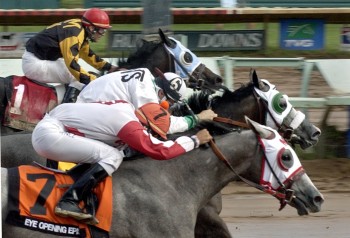
From the Albuquerque Journal
The New Mexico Racing Commission is considering changing a regulation that allows horse trainers to transfer responsibility for their horses to another person when they are not at the track on race day.
Though the regulation was intended to give trainers a way to run their horses when they couldn’t be there – due to illness, for example – it’s being abused, said Vince Mares, the Racing Commission’s executive director.
In some cases, substitute trainers, who may not be licensed, have found themselves facing sanctions for running a doped horse they might not have known was drugged. Meanwhile, the “paper trainer,” or the trainer of record, might get off scot-free.
The loophole, Mares said, also allows a trainer whose license is suspended for breaking rules to simply transfer his horse or horses to another trainer, who can continue racing them and collecting their cut of any winnings. It allows the trainer of record to continue getting a cut.
“One of the biggest problems is, when we would sanction a licensee, he would just put the horse in a family member’s name … and they were still allowed to run their horses,” Mares said.
Under state regulations, the trainer who enters a horse and whose name appears on the program is the official trainer of record. As such, that trainer is ultimately responsible for that horse’s health, conditioning and well-being.
“What we want to do is stop the paper trainer problem and make the real trainer accountable for the horses they’re responsible for,” Mares said.
Paper trainers are using the loophole so often, he said, it has become common practice at the state’s five racinos. As written, the regulation allows paper trainers to turn their horses over to unlicensed trainers who might not know anything about the horse, let alone whether it’s drug-free and physically sound enough to run.
Track stewards, the state’s top officials at a race meet, have to approve the substitute trainer, sometimes just minutes before a race, Mares said. And unless the horse tests positive for a banned substance, stewards sometimes don’t know the trainer of record is absent.
Jack McGrail, executive director of the New Mexico Horsemen’s Association, said substitute trainers allow a trainer of record to run horses at two tracks simultaneously. The practice needs to be preserved, he said, partly because of overlapping live race meets.
This year, SunRay Park near Farmington and Ruidoso Downs had 18 overlapping live race days; Ruidoso Downs and the Downs at Albuquerque had nine overlapping days; and the Downs at Albuquerque overlapped with Zia Park for nine days.
“It’s essentially a problem with enforcement on the (racing) commission’s side,” McGrail said. “We would just like to see the rules enforced as written.”
McGrail said he doesn’t see a pressing need to change the regulation and that paper trainers are “a fairly minor issue” in view of other steps the Racing Commission is taking to address problems in horse racing.
When a substitute trainer is charged with running a doped horse, McGrail said the paper trainer should accept responsibility. And, he said, substitute trainers need to understand the risks of taking on another trainer’s horse.
But the most important reason for curtailing the use of substitute trainers, Mares said, is to ensure every horse is being properly taken care of.
“The way the rules are written … the trainer should be physically present at the track,” Mares said, noting that other rules spell out a trainer’s responsibilities, including being present in the paddock before a race and attending the collection of his horse’s urine and blood samples.
The five-member, governor-appointed Racing Commission is considering a “model rule” recommended by the Association of Racing Commissioners International that would put an end to the loophole. The association, which the Racing Commission has recently joined, works to ensure the integrity of racing and pari-mutuel wagering.
“This is another step the Racing Commission is taking to curtail some of the problems we see,” Mares said. “It’s not a major problem, but it is a problem. Some of this stuff has been condoned for so many years that the industry in our state, unfortunately, gets frowned upon.”
A story in The New York Times in March about illegal doping of racehorses and subsequent breakdowns that can kill both horse and rider was highly critical of New Mexico’s horse racing industry.
Though state racing officials say the article portrayed the state unfairly, they admit the state has inconsistent enforcement and sanctions. Since then, the commission has begun adopting some Association of Racing Commissioners model regulations, including those on horse doping and stiffer sanctions against trainers and owners.
The Racing Commission is likely to consider the new rule at its next meeting, scheduled for Aug. 23 in Albuquerque.
